Being an indoor gardener brings joy and satisfaction. You can grow plants at home successfully.1 Starting vegetables from seeds brings its own rewards. This guide will teach you how to do it well.
Anyone can use this guide, whether you’ve been gardening for years or just starting. It explains how to start seeds and what to do if you face problems. With expert tips, you can plant your seeds with confidence. Then, watch as your plants grow strong and healthy.1
This guide will help you understand the benefits of both direct sowing and transplanting. It also shares tips for starting seeds successfully. You’ll discover the best tools, like seed mixes and containers. Plus, you’ll learn about the right light and water for your seeds.1
By the end, you’ll know all about planting and caring for your seeds. You’ll be ready to create a garden that both looks beautiful and provides fresh veggies.1 Let’s get started and learn how to plant seeds indoors the right way!
Key Takeaways
- Planting vegetable seeds is a crucial step for successful indoor gardening.
- This guide covers everything from seed starting techniques to troubleshooting common issues.
- Practical advice and actionable tips will help you confidently cultivate healthy, thriving plants indoors.
- Learn about essential equipment, materials, and strategies for optimal seed starting and seedling care.
- Unlock the secrets to creating a lush, productive indoor garden that provides a steady supply of fresh vegetables.
Understanding Seed Starting
Starting your vegetable garden off right begins with the correct seed starting methods. It’s vital to know which vegetable seeds are best for indoor starting or outdoor planting.2 First-timers should pick seeds of tomatoes, peppers, lettuce, and cucumbers for indoors.2 On the other hand, beans, melons, and radishes do well when directly planted outside.
When to Start Seeds Indoors
Figuring out the right time to start your seeds indoors is key to a good harvest.2 It depends on when your area’s last frost is expected and your Hardiness Zone.2 Generally, seeds should be started indoors 6-8 weeks before the final frost. This gives time for strong roots to grow and healthy plants to appear.
Determining Your Hardiness Zone
Knowing your local climate and USDA Hardiness Zone is very important. The zone map shows the coldest temperatures you expect each year. This helps you choose the right seeds and plan a successful growing season.
| Hardiness Zone | Average Annual Minimum Winter Temperature |
|---|---|
| 1 | Below -50°F |
| 2 | -50°F to -40°F |
| 3 | -40°F to -30°F |
| 4 | -30°F to -20°F |
| 5 | -20°F to -10°F |
| 6 | -10°F to 0°F |
| 7 | 0°F to 10°F |
| 8 | 10°F to 20°F |
| 9 | 20°F to 30°F |
| 10 | 30°F to 40°F |
| 11 | 40°F and above |
How to Plant Vegetable Seeds
Starting with the right seeds is key to growing vegetables. You need to prep the soil and place the seeds right. This ensures your plants start out strong. Whether you’re growing indoors or in your garden, we’ll cover all the steps.
Step 1: Prepare Seeds and Markers
First, get your seeds and something to mark them with. Sort your seeds by type and make sure they’re good quality.3 Fresher seeds grow better. Don’t forget to label everything clearly, including when you planted them.
Step 2: Moisten the Soil
It’s important to moisten your soil lightly before using it. This keeps it aerated and the right moisture level for seeds. Don’t make it too wet, to avoid plant diseases.
Step 3: Add Soil to Containers
Put the soil in your pots, trays, or in the garden, if that’s where you’re planting. Make the top level flat and smooth. This makes a good place for the seeds.
Step 4: Tamp the Soil
Now, press the soil down gently with your hand or a tool. A firm soil surface helps seeds grow well. It also stops tiny seeds from moving around too much.
Step 5: Plant the Seeds
Follow the seed packet’s advice on how deep and far apart to plant.3 Press the seeds in gently. Remember, small seeds like being close to the surface. For them, just sprinkle, then cover slightly with soil.
Stick to these steps and you’ll do great planting your seeds. Keep an eye on water and light for your new plants. Good luck!
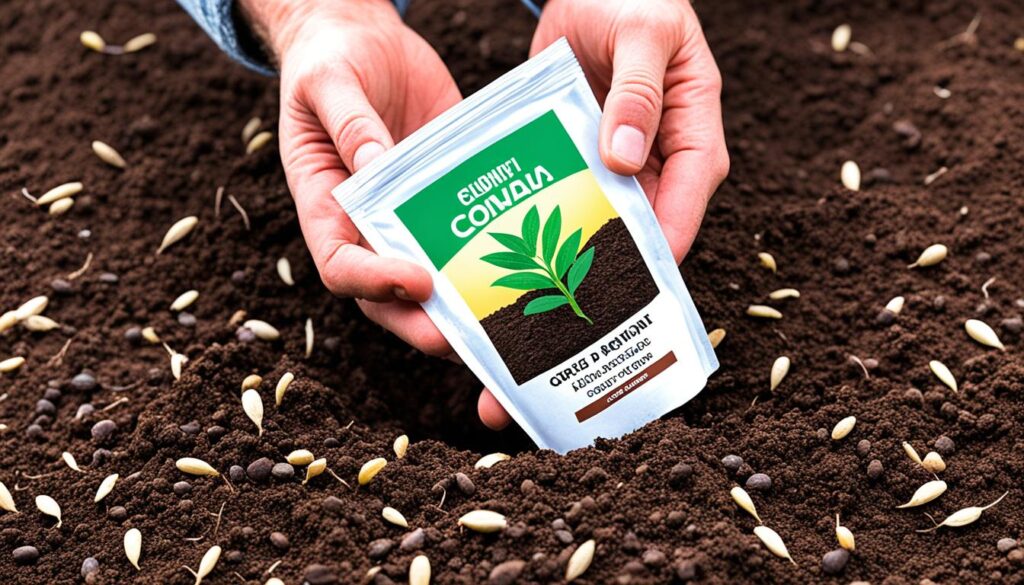
Seed Starting Essentials
Successful indoor gardening requires the right gear and materials. Seed starting containers play a big part in this. Choosing the best seed starting mix matters too. Knowing these essentials will help you grow strong, healthy seedlings.4
Choosing Containers for Seed Starting
Indoor seed starting begins with selecting the right container. Seed starting trays that have separate cells are a great pick. They give each seedling space for root development.4 You can also use things from around your house to save money. Try egg cartons, yogurt cups, or paper cups. These are good alternatives for seed starting containers.4
Selecting a Seed Starting Mix
Pairing the right container with a quality seed starting mix is crucial. Opt for a mix that is sterile, light, holds moisture, and drains well.4 Using your garden soil isn’t recommended. It could contain pests, diseases, or weed seeds harmful to your seedlings. Instead, pick a seed starting mix designed for optimum plant growth.4
| Seed Starting Essentials | Recommended Products |
|---|---|
| Seed starting containers | Seed starting trays, egg cartons, yogurt cups |
| Seed starting mix | Sterile, lightweight, moisture-retaining soil |
| Seed starting supplies | Grow lights, heat mats, water sprayers |
Getting the correct seed starting containers, mixes, and supplies is key. With the right care, your plants will start strong. This leads to a healthy and productive indoor garden.4
Providing Proper Lighting
Good seed starting lighting is key for planting indoor seedlings.2 Seedlings should get at least 15 hours of light daily to grow well.2 Grow lights for seed starting help make sure your indoor plants get enough light to be healthy.
Lots of gardeners now use LED bulbs for starting seeds inside. They are better than fluorescent lights because they use less energy and last longer.5 Even though LED bulbs cost more upfront, they’re a smart choice for people who garden at home.5 You can find grow lights at stores, online, and in gardening shops. This makes it easy to find the right ones for your plants.
Plants need light in the 400 to 700-nanometer range to grow.5 Many lights are now made specifically for either leafy greens and seeds, or for flowers and fruit.5 The strength of light, measured by photosynthetic photon flux (PPF), is 10-50 for most lights. Seedlings such as peppers or tomatoes do best with stronger light when they start.5
When seedlings grow older inside and spend more time there, they need even more light to form strong stems. This extra light also helps them get a good start for the growing season.5 Getting right the placement and timing of your grow lights as your plants grow is crucial to their success.
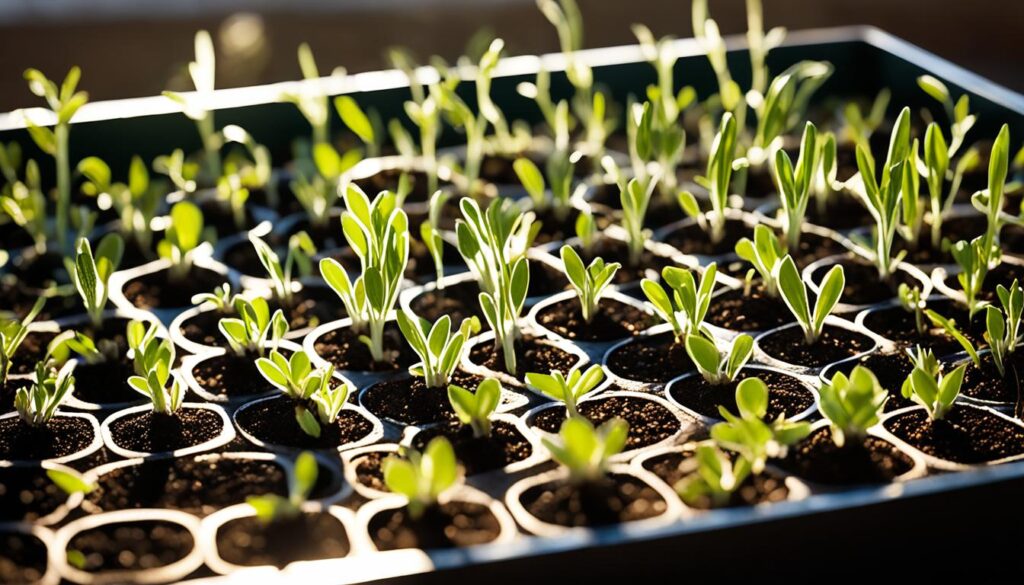
Watering Seedlings
Watering is vital for seed germination and seedling growth. The guide discusses ways to keep soil moist without being too wet. It includes bottom watering benefits and talks about how to keep the soil just right throughout seed starting.6
Bottom Watering Technique
The bottom watering method works well for watering seedlings. It means putting seed trays in a dish of water. This lets the plants take in water from the bottom.6 Using this way makes sure the roots get water they need. It also stops the soil from getting too wet on top. This can be harmful to the plants.6
To use bottom watering, place trays in water for a short while. Let the water soak up to the top. Then, get rid of any extra water.6 This method keeps the plants well-watered. And it avoids problems like packed soil and fungi that come with watering from above.6
Gardeners should get good at watering seedlings. This ensures the plants get the water they need to grow strong.6 It’s important to keep an eye on the plants and adjust how much you water. Things like container size, age of the plants, type of soil, temperature, and humidity all affect how much water plants need. Following these tips will help the seeds grow into healthy plants.6
Fertilizing Young Seedlings
Vegetable seedlings need more nutrients to grow as they get older.7 Start fertilizing when they grow 4 to 6 true leaves, not counting the first leaves they had.7 Some soils already have a bit of food for seedlings.7 But, as plants get bigger, switch to a slow-release, all-purpose organic fertilizer for the garden. Use water-soluble organic fertilizer for seedlings.7
When you feed seedlings, use less than what the label suggests.7 Be careful with fertilizers high in nutrients, like 30-30-30, as they might hurt young plants.7 However, liquid seaweed fertilizers like Bionik 0.36-0-0.22 are good for growth.7
A special fertilizer, Bionik All Purpose 1-0.5-0.3, with insect frass, can make plants grow and produce more.7
It’s important to be careful when adding compost to the seedling mix. Pathogens and toxic stuff could be in compost that’s not fully broken down.7 Don’t add too much compost, just 5 to 10%, so it doesn’t change the soil too much.7
| Fertilizer | N-P-K Ratio | Cost |
|---|---|---|
| Neptune’s Harvest Fish & Seaweed Fertilizer | 2-3-1 | $46.88 for 4 oz |
| Grow Big by FoxFarm | Unknown | $13.79 for 16 oz |
Choose water-soluble fertilizers for seedlings, as they need a weaker mix.8 The Brass Siphon Mixer is great for correctly mixing water-soluble fertilizers, pesticides, or fungicides.9
For vegetable seedlings, use a balanced fertilizer like 20-20-20. It has equal parts potassium, phosphorous, and nitrogen.9 With the Brass Siphon Mixer, for every 16 gallons of water, add one gallon of fertilizer mix.9 In the greenhouse, feed vegetable seedlings twice a week for strong roots and growth before planting outside.9
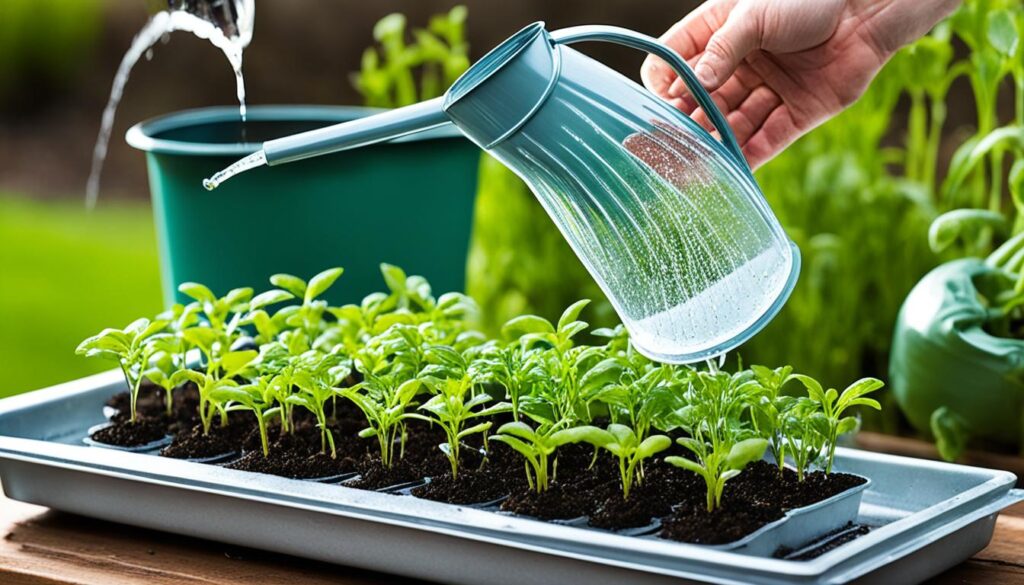
Hardening Off Seedlings
Before you move your seedlings to the garden, they need to get used to the outside.10 This step is called “hardening off.” You do this by letting them spend time outside, getting more sun, wind, and different temperatures each day for 7 to 14 days.10
Using a Cold Frame
A cold frame helps a lot with the hardening-off process.10 It’s like a tiny house for your seedlings that makes their move outside easier.10
To start, move your seedlings into the cold frame 7 to 14 days before they’re going into the ground.10 Inside, it should be at least 50 degrees but not more than 80 degrees Fahrenheit.10
At first, let them stay outside for only a few hours a day. Then, slowly increase this time.10 This method helps the seedlings get used to outside living without getting shocked or hurt.10
After 7 to 14 days in the cold frame, your plants are ready for their new home.10 Remember to give them plenty of water after planting. It reduces the stress of the big move.10
Some plants, like tomatoes and peppers, need extra help to adjust.10 So, it’s a good idea to give all seedlings an outdoor mini-vacation. Skipping this step might hurt your plants.10
Direct Sowing Vegetable Seeds
Some veggies do well when started inside. Others like being11 sown right in the garden. The hill and trough methods work great for this. They are ways to plant seeds outdoors from the start. Direct sowing vegetable seeds helps them grow strong and healthy.
The Hill Method
The hill method is great for plants that need a warm start. This includes melons, squash, and cucumbers. You make small hills of soil, shaped like circles. These are about 4-6 inches high and 12 inches wide. Leave 3-4 feet between each hill. Plant 4-6 seeds per hill, 1 inch deep. Once the plants appear, keep the 2-3 strongest in each hill.
The Trough Method
Growing plants with the trough method means they are evenly spaced. First, create shallow trenches, about 1 inch deep. Do this with the spacing the seed packet suggests. Plant the seeds along the trough, as directed. After they sprout, thin them to the right distance so they can grow well.
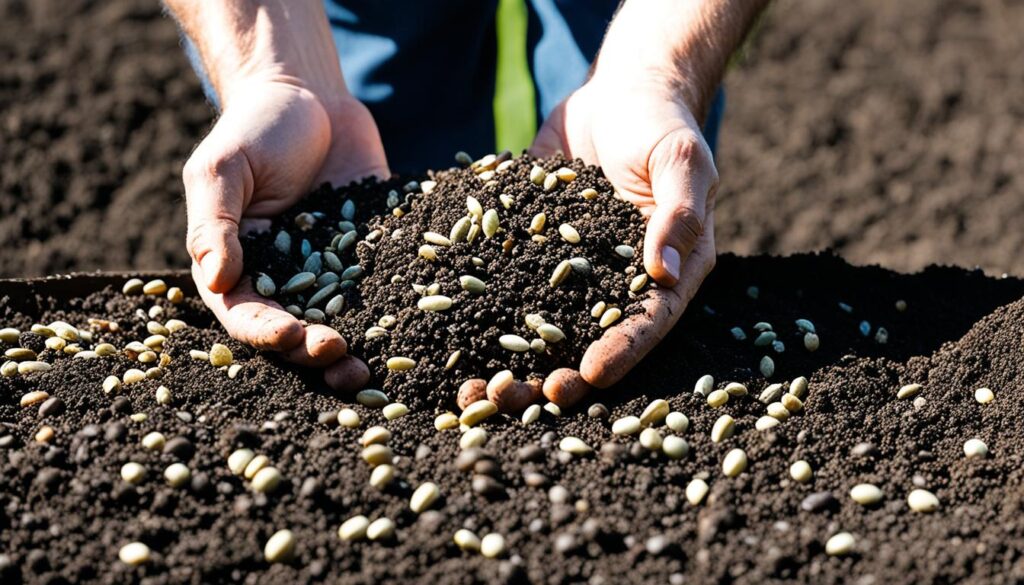
The hill and trough methods are both good for sowing seeds outside. Learning these ways helps gardeners have success with their seeds. This leads to lots of healthy veggies to enjoy.
Seed Spacing and Depth
Getting the seed spacing and planting depth right is key for healthy plants. For seed planting, always check the seed packets first. They tell you how far apart and how deep each seed should be planted for best results.
Knowing the basics also helps. A guideline we mentioned earlier suggests different planting depths, from ⅛ inch to 4 inches, based on the plant.12 Plants need room to grow, ranging from 1 inch apart for carrots to 36 inches for some vines, like watermelon.12
Aside from what’s on the seed packet, think about plant size and how they grow.12 Also, consider how deep to plant the seeds. This affects temperature, moisture, and root growth. These, in turn, impact the plant’s health and how well it grows.12
Checking Seed Packet Instructions
Always read the seed packet instructions first when you plant seeds. They guide you on how to plant and space the seeds to help your plants thrive. Following these tips ensures your seeds grow well and produce lots of veggies.131214
The seed packet instructions are made to give you the best advice for each seed. By sticking to these pointers, your plants will grow healthy. This is key to a successful garden, whether it’s inside or outside.
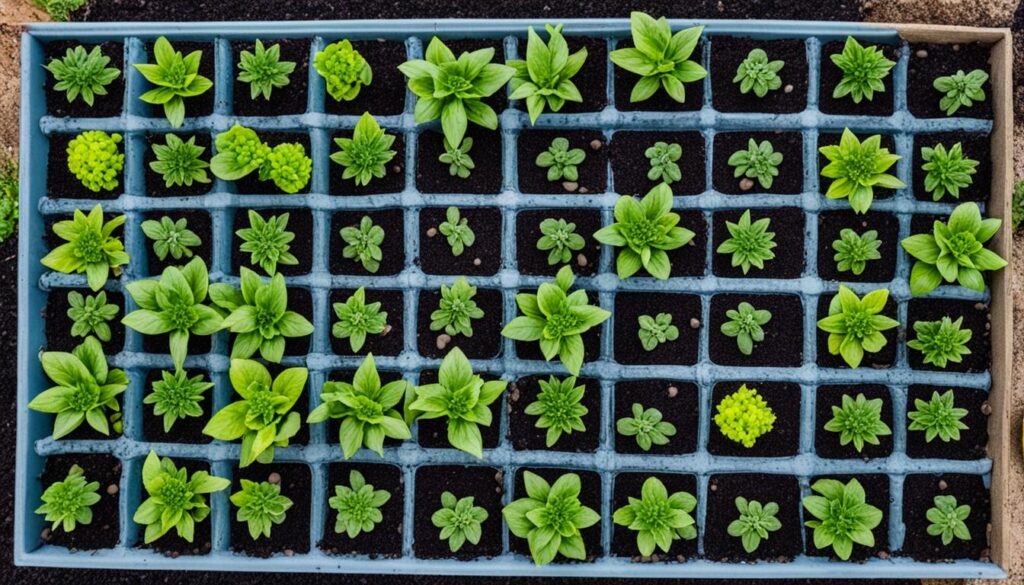
Troubleshooting Common Issues
Even the best gardeners face challenges when starting seeds. These issues can be tackled with the right know-how. This ensures your seeds grow strong and healthy. Let’s look at several common problems together:
Poor Germination Rates
Low germination rates can be a major headache. The main suspects are old or expired seeds. Some seeds last a short time, while others are good for years.15 Check the ideal soil temperatures for your seeds to boost germination.15 Also, getting the right soil moisture level is key. It should be just right, not too dry or too wet.16
Damping Off Disease
Damping off is a disease that makes seedlings collapse. It’s caused by harmful fungi.17 Using cinnamon on the soil can fight this disease. Studies suggest it works like using pesticides.15
Leggy Seedlings
Leggy seedlings have tall, weak stems because they lack light.15 Weak seedlings can’t stand changes in water well. To fix this, give them lots of light. They need 16-20 hours a day.15
By facing and solving these issues, your seeds will have a better chance to grow. This leads to a great harvest later on.
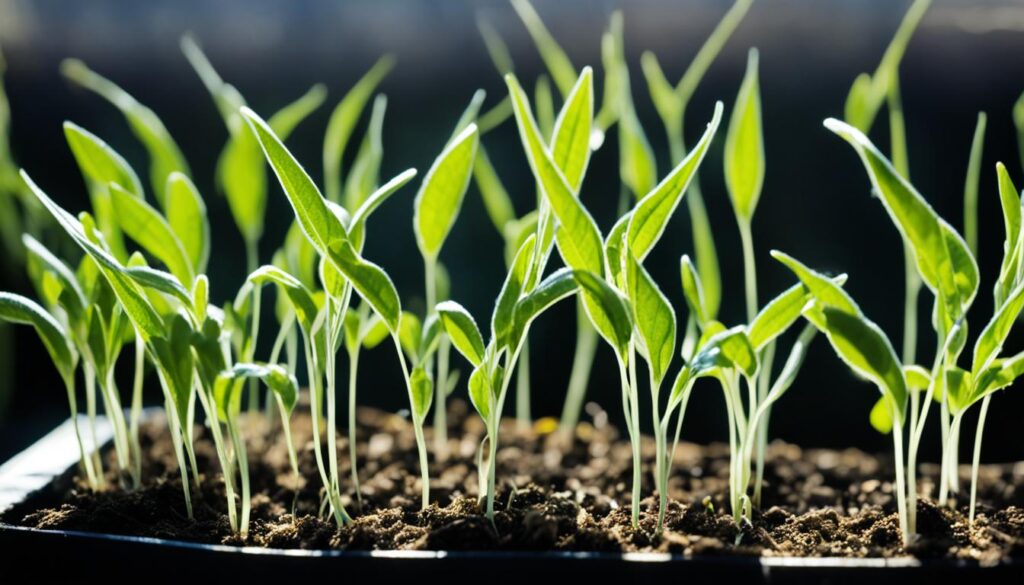
Conclusion
We’ve covered a lot about planting vegetable seeds in this guide. Learning how to start seeds plays a big part in making your garden grow well. The right know-how on planting, tools, and steps help gardeners grow all kinds of plants. This happens both inside and outside.
This guide showed you how to pick seeds and move plants from inside to outside. It explained how to care for your seeds and plants so they grow strong. By following simple rules on how to plant, prepare soil, give light, and water, you’ll see great veggies in your garden.18
Growing vegetables from seeds is not just fun, it’s also a chance to learn. Use these ideas, problems are just part of the fun! Be patient, work hard, and with these tips, you’ll do great with your garden.19
So, are you ready to start planting? You can plant your seeds inside or right in the garden. The secrets to vegetable gardening, seed starting, and indoor gardening are all here. Enjoy the journey and see your plants grow!
FAQ
What are the best vegetable seeds to start indoors versus directly sow outdoors?
Tomatoes, peppers, and lettuce grow best when started indoors. Beans, melons, and radishes do better when directly sown outdoors.
When is the optimal time to start vegetable seeds indoors?
The best time depends on your area’s last frost date and your Hardiness Zone.
What is the step-by-step process for planting vegetable seeds?
First, prepare seeds and markers. Moisten soil. Then, add soil to containers and tamp it down. Finally, sow the seeds gently.
What essential equipment and materials are needed for successful seed starting?
You’ll need the right containers and a quality seed starting mix. This mix should provide nutrients and good drainage for your seedlings.
How much light do seedlings need when growing indoors?
Seedlings need around 15 hours of bright light each day. Place them near south-facing windows or use grow lights.
How do I maintain the proper soil moisture for my seedlings?
Keep the soil moist, but not too wet. Bottom watering is a useful technique to prevent over-watering.
When and how should I fertilize my young seedlings?
Fertilize when the seedlings have their first true leaves. Use organic liquid fertilizer. Follow the instructions for how and when to apply it.
What is the “hardening off” process, and why is it important?
Hardening off slowly gets seedlings used to outdoor conditions. It helps them survive and thrive after transplanting.
What are the different methods for direct sowing vegetable seeds outdoors?
We’ll cover the hill and the trough methods. The hill method warms the soil for specific seeds. The trough method is great for evenly planting seeds.
How do I ensure proper seed spacing and planting depth?
Read the seed packets for spacing and depth instructions. Our guide will also provide general advice for most common vegetables.
What are some common challenges I may encounter when starting vegetable seeds, and how can I address them?
The guide addresses poor germination, “damping off,” and leggy seedlings. It gives tips to spot and fix these issues.
Source Links
- https://www.themakermakes.com/blog/starting-vegetable-seeds-indoors-why-what-you-need-and-how
- https://www.gardeners.com/how-to/how-to-start-seeds/5062.html
- https://www.almanac.com/sowing-seeds-vegetable-garden
- https://www.swansonsnursery.com/blog/how-to-start-seeds-indoors
- https://extension.umn.edu/yard-and-garden-news/grow-lights-starting-seeds
- https://www.epicgardening.com/water-seedlings/
- https://laidbackgardener.blog/2023/04/09/dont-forget-to-fertilize-your-seedlings/
- https://thedallasgarden.com/when-and-how-to-fertilize-young-seedlings/
- https://growhoss.com/blogs/study-hall/best-way-fertilize-vegetable-seedlings
- https://www.thespruce.com/how-to-harden-off-plants-1402554
- https://www.thespruce.com/how-to-direct-sow-garden-seeds-2539874
- https://ponicslife.com/seed-planting-depth-and-spacing-chart-for-vegetables-a-quick-guide/
- https://www.thingsgreen.com/blog/how-to-plant-vegetable-seeds
- https://www.gardeningknowhow.com/edible/vegetables/vgen/plant-spacing-chart.htm
- https://umbelorganics.com/common-seed-starting-problems/
- https://frostygarden.com/topics/9-common-problems-with-vegetable-seed-germination/
- https://blog-fruit-vegetable-ipm.extension.umn.edu/2020/04/troubleshooting-seedling-issues.html
- https://www.aces.edu/blog/topics/crop-production/vegetable-seedlings-production/
- https://vegplotter.com/blog/preparing-your-vegetable-garden-for-spring-planting
